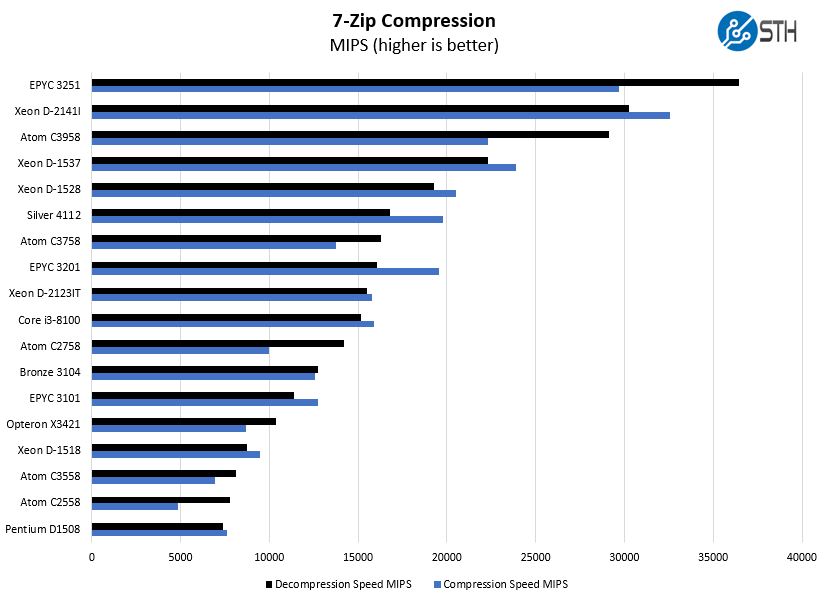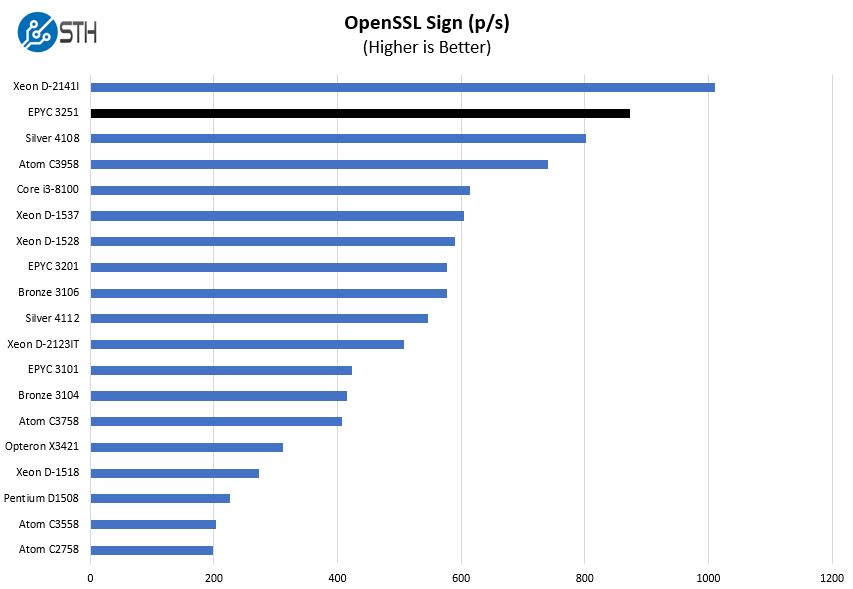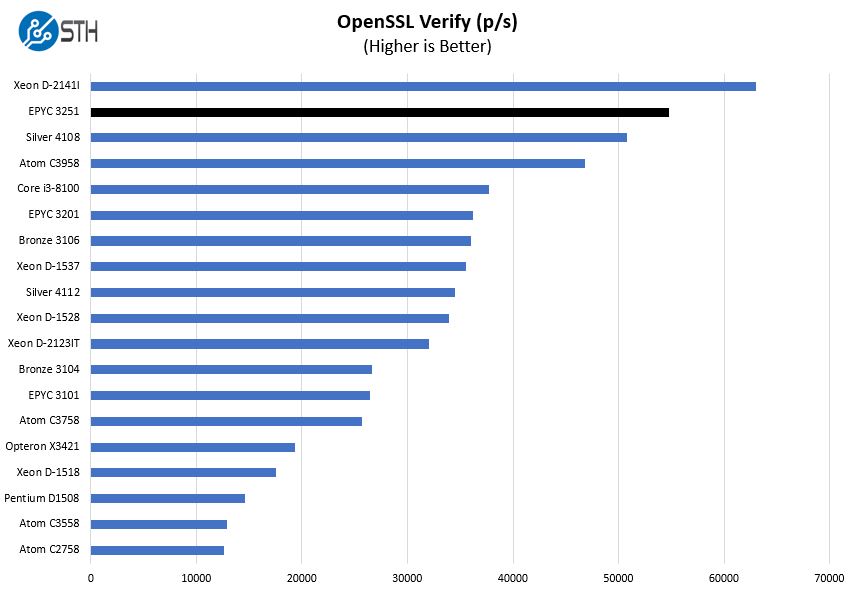Supermicro M11SDV-8C-LN4F AMD EPYC 3251 Benchmarks
For this exercise, we are using our legacy Linux-Bench scripts which help us see cross-platform “least common denominator” results we have been using for years as well as several results from our updated Linux-Bench2 scripts. At this point, our benchmarking sessions take days to run and we are generating well over a thousand data points. We are also running workloads for software companies that want to see how their software works on the latest hardware. As a result, this is a small sample of the data we are collecting and can share publicly. Our position is always that we are happy to provide some free data but we also have services to let companies run their own workloads in our lab, such as with our DemoEval service. What we do provide is an extremely controlled environment where we know every step is exactly the same and each run is done in a real-world data center, not a test bench.
We are going to show off a few results, and highlight a number of interesting data points in this article.
Python Linux 4.4.2 Kernel Compile Benchmark
This is one of the most requested benchmarks for STH over the past few years. The task was simple, we have a standard configuration file, the Linux 4.4.2 kernel from kernel.org, and make the standard auto-generated configuration utilizing every thread in the system. We are expressing results in terms of compiles per hour to make the results easier to read:

Performance of the embedded AMD EPYC 3251 is very good. Just for comparison, we added a dual Westmere-EP generation dual Intel Xeon X5670 setup here. This dual CPU 2010 configuration used well over four times the power for the two CPUs and IO hub. In nine years, packaging has reduced by about one quarter, power about one quarter, and cost by about a quarter for a similar level of performance.
c-ray 1.1 Performance
We have been using c-ray for our performance testing for years now. It is a ray tracing benchmark that is extremely popular to show differences in processors under multi-threaded workloads. We are going to use our 4K results which work well at this end of the performance spectrum.

Here the AMD “Zen” architecture performs very well. We wanted to show here how much of a performance lead the AMD EPYC 3251 embedded part has over the CPU performance of the NVIDIA Jetson TX2. The Jetson TX2 is a lower power part with a GPU, but one can see an Arm point of time example in this embedded segment over the EPYC 3251.
7-zip Compression Performance
7-zip is a widely used compression/ decompression program that works cross-platform. We started using the program during our early days with Windows testing. It is now part of Linux-Bench.

Here, the AMD EPYC 3251 performance is substantial, notching another win over the 8-core Intel Xeon D-2141I competition on the decompression side. The Intel Xeon D-2141I performs above the AMD EPYC 3251 on the Supermicro M11SDV-8C-LN4F on the compression side.
Sysbench CPU test
Sysbench is another one of those widely used Linux benchmarks. We specifically are using the CPU test, not the OLTP test that we use for some storage testing.

Here the roles reverse and the Intel Xeon D-2141I takes the lead. One can see the clock speed and SMT advantages with 16 threads on the AMD EPYC 3251 versus the AMD EPYC 3201.
OpenSSL Performance
OpenSSL is widely used to secure communications between servers. This is an important protocol in many server stacks. We first look at our sign tests:

Here are the verify results:

The AMD EPYC 3251 offers smaller packaging sizes, lower power consumption, and more performance than the Intel Xeon Silver 4108. That is impressive. The Intel Xeon Silver 4108 has more PCIe lanes and I/O, as well as more memory channels. On the other hand, the AMD EPYC 3251 has a higher memory capacity than the Intel Xeon Silver 4108.
UnixBench Dhrystone 2 and Whetstone Benchmarks
Some of the longest-running tests at STH are the venerable UnixBench 5.1.3 Dhrystone 2 and Whetstone results. They are certainly aging, however, we constantly get requests for them, and many angry notes when we leave them out. UnixBench is widely used so we are including it in this data set. Here are the Dhrystone 2 results:

Here are the whetstone results:

AMD EPYC chips tend to fare well in these tests. Again, we can see performance competitive to Intel Xeon D-2141I levels but at a lower cost. The Xeon D-2141I has a 30% higher TDP (65W v. 50W) than the AMD EPYC 3251 powering the Supermicro M11SDV-8C-LN4F.
Chess Benchmarking
Chess is an interesting use case since it has almost unlimited complexity. Over the years, we have received a number of requests to bring back chess benchmarking. We have been profiling systems and are ready to start sharing results:

Overall, having a lot of cores in a 50W TDP SoC helps here, as we have seen in our other tests.
Next, we are going to look at the Supermicro M11SDV-8C-LN4F power consumption followed by our final words.




Thanks for the informative review, Patrick. This board seems rather MPD to me. Four DIMMs, four SATA, four gigE. It’s not a storage machine: needs more SATA; it’s not much of a router: needs more gigE; it’s not great as a VM host: 128GB DIMMs are frightfully expensive. And any of these applications would benefit from 10gigE.
Just a guy: I would guess this board is just a beginning in a set of boards from Supermicro build around this processor series.
I would totally be in in mATX with dual NVME and 8 Sata ports. Something like this board here:
https://www.supermicro.com/products/motherboard/X11/X11SCH-LN4F.cfm
I’d prefer a single 10GbE SFP+ to quad GbE these days. The limited SATA isn’t concerning to me, it would be easy enough to add an HBA if one really wanted lots of disks.
This would be a good upgrade from my C2558 if it had SFP+
Is there any idea of pricing on these parts? I’m checking our typical SuperMicro supplier here and these parts aren’t even listed yet.
@Bob these parts seem to have the same naming scheme as their Xeon D counterparts, so I would expect a TP4F suffix to have 10Gbit on board as well as (hopefully) some F variants for lower budget embedded appliances. The CPU performance/Watt is perfectly aligned with our edge caching use cases, so I’m eagerly awaiting parts and variants to be available.
https://www.supermicro.com/Aplus/motherboard/Embedded/EPYC3000/
Weirdly they all say they have up to 8 SATA and 10GBase-T
#David
ive just bourght a M11SDV-8C+LN4F from poland and awaiting its arival. I gave 440 euro + shipping for it, to denmark
#Brian
Where did you buy that M11SDV-8C+LN4F?
Hello,
Do you think that this motherboard will fit into the CSE-721TQ-250B chassis? This motherboard has the same dimensions as the supported Xeon boards, and the compact mini-tower chassis would be more useful (and quiet!).
It will, but I would suggest getting the -8C+- version as in the 721TQ you will need an active CPU cooler.
Did the RAM operate at 2666 Mhz? Page 16 of the manual (https://www.supermicro.com/manuals/motherboard/EPYC3000/MNL-2172.pdf) states “When the motherboard is fully populated with 4 modules of single rank DDR4 RDIMM, the memory will operate at speed of 2133MHz”. It gives other cases where RAM speed is diminished, to the point where I’m not sure what configuration of ECC DIMMs should be used to get full 2666 MHz memory speed when using all 4 DIMM slots.
Any ideas?
Alex, we always do performance testing at full speed RAM.
Patrick, yes I saw you used 2666 MHz DIMMs. My point was that the motherboard manual implies that the board can only use RAM at a maximum of 2133 MHz when all 4 DIMM slots are used (see the section I quoted in previous comment). Am I reading it wrong? Were you able to verify the RAM speed?
MNL-2172.pdf (page 16)
“When the motherboard is fully populated with 4 modules of single rank DDR4 RDIMM, the memory will operate at speed of 2133MHz.”
I’m not sure why you guys care about RAM speed so much. It’s standard that most servers, even the E5’s and big EPYC will downclock when fully populated. That’s normal. You can always manually set RAM speed. Easy. It’s working in the boards we’ve deployed and its what you’d always do if you cared about RAM speed. Some companies have their autotuning defaults to keep speed the same and give it fancy names. I don’t see what’s different with this one.
€700+ for the board.
Yikes. According o the domain name servethehome, this is hardly appropriate product.
How many homes can afford that for just a MoBo + CPU ?
For a budget solution, one might be better of with consume grade stuff, downclocked CPU and ECC compatible board…
Brane – I think many here can since they are IT professionals. Just as a FYI – over the last 10+ years STH has become the largest dedicated server review site in the world and we scale to the large multi-system servers.
Feel free to check out the history here: https://www.servethehome.com/sth-turns-10/
Patrick Kennedy:
Fine. But it still caries hefty pricetag for what it is…
Epycs are better binned than off-the-shelf stuff, I understand that.
ECC certification is wrth af few €, too since it already is working in all chips, so it is only the matter of official stamp and perhaps one testing step more during production ( if even that).
So, what is left on the board that is worth those extra €300-400 ?
For us not-exactly profeesionals it seems better to look for off-the-shelf stuff.
R7 1700 is cheap these days ( not much more than €100!) and undeclocked should churn much more than Epyc3000. On one elcheapo uATX board should work just fine.
If I opt for ECC RAM, I’d have to narrow my board choices and use unbuffered ECC, but that’s OK for my useage.
Or perhaps Asus, Asroc or Gigabyte might decide one of these days to dip their toes in these waters…
If the board does not meet your needs, and that is a realization after reading the review, then I think that is a success on our end. Our goal is to present all of the features so people can make decisions. For some, the embedded part makes a ton of sense. For others, it does not. That is the same with any platform and we just want to ensure people have access to enough information to make that decision.
Hi Patrick,
I noticed the X10SDV-TLN4F motherboard (for the XEON D-1541) has x6 SATA3 ports, but this one only has x4. What would be the recommended adapter in order to make use of additional SSDs, as the CSE-721TQ-250B chassis has space for an additional x2 drives?
This looks very interesting, however I see that vs Xeon-D this is not officially supported by VMWare, I found some comments around the web that it had some issues and some updates fixed them, but still is not clear to me how stable it could be. I primary will use it as a home lab server so I can afford a non-official support, however a partially support is not an option, anyone else had the chance to test this platform with a VMware environment (vcsa + nsx + vsan)?
Thanks!
Any thoughts on what the format of the heat sink is? What can I replace it with?
What is factored in when measuring the Power Consumption of these boards ?
Is it just the CPU ?
Or is it the entire configuration ?
If so what Config is it ? CPU+Board+2xRam+1 Drive ?
Entire config. You got it right.
Hi Patrick,
Do you think we can replaced the heatsink with corsair hydro series H60/75?
Hey Patrick, do you intend to review the asrock Epyc platform as well (EPYC3251D4I-2T)?
The 2 boards are interesting, because they come with 2 10GBe, as well as 6 Sata ports by default, unlike the supermicro boards. It would be nice to see how that affects power consumption.
Also do you think there will be ATX Boards with Epyc 3000 Processors in the near future ? Because cutting down their PCIe lanes with the mini-itx design realy sucks.
Some information about idle power use to something like me who uses the platform in residential setting where the system is running 24/7, workload is bursty and idle power use is very important.
With the following configuration I’m getting 22.3W at idle.
M11SDV-8C+-LN4F with EPYC 3251.
Stock fan replaced with Revoltec RL036 (mostly due to noise reduction, but likely it helps power use too).
64GB DDR4-2400 RAM (2x32GB HMA84GR7MFR4N-UH)
WD SN750 1TB NVME SSD
Only single gigabit network cable is connected. BMC is left unconnected.
PSU is 120W 12V power brick (Chieftec CDP-120ITX).
VGA is disabled via jumper (saves 1W)
“powertop –auto-tune” has been run (saves 0.2W if VGA is enabled, 1.1W if VGA is disabled)
The measurement has been made on console login screen of stock Debian 11 that had powertop installed. The power meter is not calibrated.